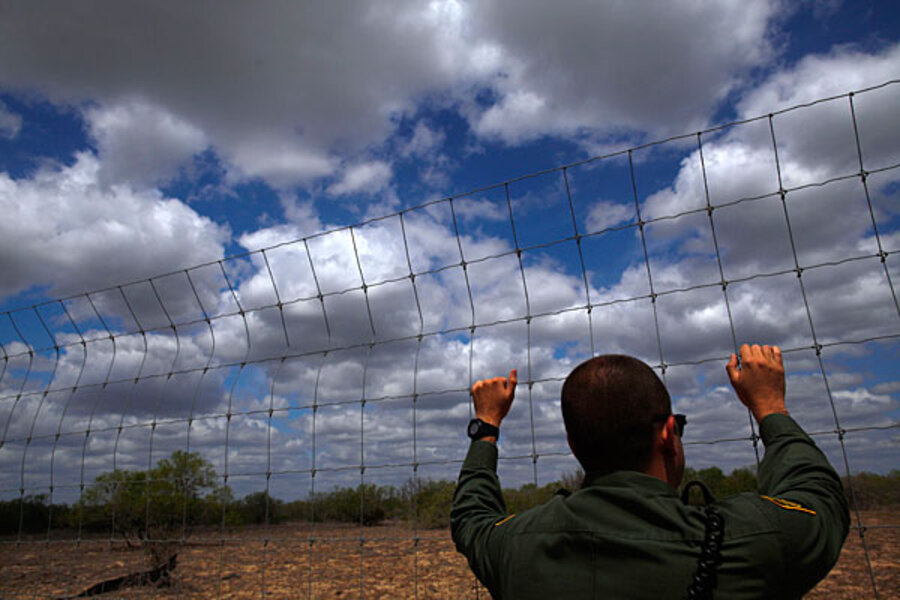Border apprehensions up again. Big blow to immigration reform efforts?
| Tucson, Ariz.
After years of steady declines, the number of people caught trying to cross the US-Mexican border illegally is ticking slowly upward.
The latest data from Customs and Border Protection (CBP) show an increase of 13 percent over last year for the six-month period ending April 1. This follows fiscal year 2012, which saw a 9 percent rise in apprehensions along the southern border – the first such annual increase since 2004. [Editor's note: The original version misstated the full name of the CBP.]
Demographers suggest that the numbers do not necessarily represent the beginning of a reversal, but rather natural fluctuations within evolving trends. More border traffic appears to be shifting away from Arizona, where the border patrol has increased its presence, and a rising share of the border-crossers in Texas are coming from Central America, not Mexico, they note.
But the report could be significant in Congress, where many conservatives say their support for immigration reform depends on establishing a secure border. While lawmakers are divided over a way to measure security, rising numbers could complicate efforts at compromise.
The CBP data represent the half-year tally for fiscal year 2013. Along the 2,000-mile US-Mexican border, the agency recorded 189,172 arrests. While those numbers are up from last year, they are still near historic lows. Only two years have recorded fewer first-half apprehension figures than this year – 2011 and 2012.
"We really did hit bottom on the flows, and they may have gone up a little bit," says Jeff Passel, a senior demographer at the Hispanic Pew Center. "But they are well below what we saw in the middle of the last decade and are a small fraction of what we saw around 2000."
In 2000, apprehensions hit 1.68 million. At the current pace, apprehensions this year would near 380,000.
Immigration, demographers note, is driven by an array of factors, including border enforcement, and the economic conditions in Central America and Mexico.
In recent years, the ramping up of US border security, combined with the stuttering US economy has helped depress illegal immigration. Yet the more powerful long-term trend could be declining birthrates and rising urbanization in Mexico, which has led to fewer migrant workers coming to the US to look for jobs.
While the US economy is showing signs of slow improvement, the fundamentals haven't changed, says Douglas Massey, a sociologist at Princeton University and codirector of the binational Mexican Migration Project.
"This is by no means a return to the mass migration that we saw in the 1990s and early 2000s," he says. "The big driving conditions on the Mexican side of the border have shifted."
What has shifted on the US side, perhaps, is the border patrol buildup. Illegal immigration has historically flowed to where border-crossing is easiest. In the 1990s, that was the San Diego sector. When the border patrol beefed up its presence there, Arizona's Tucson sector become the most active. Now, there are signals that the border patrol's mounting presence in the Tucson sector could be driving border-crossers to Texas.
The Rio Grande Valley in south Texas saw a significant spike in apprehensions in the first half of FY 2013. In March, it recorded more apprehensions than any other sector. Its 16,700 apprehensions in March represented a 67 percent increase over the same period last year. Meanwhile, the Tucson sector had 15,009 apprehensions in March, a 9 percent drop from last year.
With immigration reform before Congress, some lawmakers are saying that the lure of US citizenship – along with budget cuts that hit the border patrol – are also driving up illegal immigration. “Part of it is that word has gotten south that sequestration has reduced our ability to surveil, and there may be comprehensive immigration reform,” said Sen. John McCain (R) of Arizona – a supporter of immigration reform – speaking of the fiscal year 2012 data.
With many Republicans saying that the the southern border must be certified as "secure" before immigration reforms can begin to take effect, the new numbers are likely to play a role in ongoing negotiations over how to measure security.






